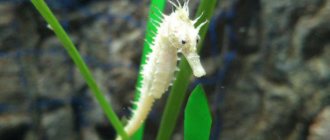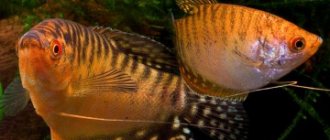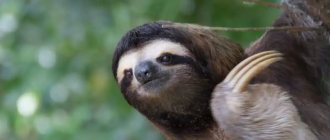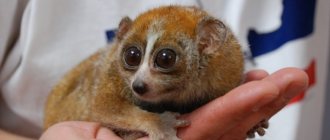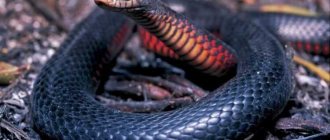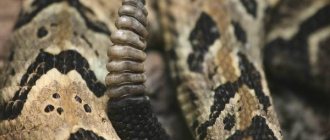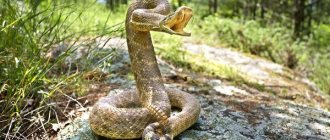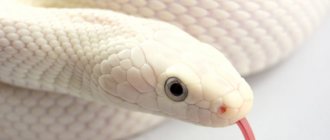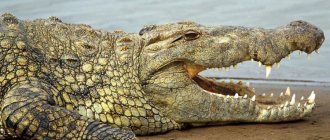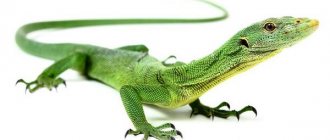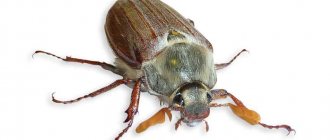Snakes of Africa are not just dangerous creatures that pose a certain threat to humans.
Snakes rarely attack first; they are afraid of humans, so although their bites can be fatal, and in some cases inevitably fatal, they are quite rare.
Tourists visiting Africa need to be extremely careful. Because African medicine is not so modern and any snake bite can be fatal.
Labaria or kaisaka
Only 50 mg of its poison is enough to cause death. This representative of pit snakes from the viper family lives in the tropics of South America and some regions of Central America. This aggressive snake is not afraid of people and often crawls into their homes. Its yellow-brown color is quite invisible. The snake's venom acts rapidly, and death occurs within a few minutes after the bite. Most often, the victims of this reptile are workers of coffee and banana plantations.
This is interesting: Interesting facts from the life of a wolf pack
Nile crocodile
The Nile crocodile is the largest crocodile in Africa. Inhabits natural reservoirs throughout the continent. The length of male Nile crocodile varies from 3 to 5.5 m, weight can reach 700 kg.
Nile crocodile: Wikipedia
Due to their size, crocodiles have a good chance in confrontation with other large African animals. As National Geographic notes, the Nile crocodile has a well-deserved reputation as a man-eater. It is difficult to determine the exact number of victims of this species.
Most of the victims of the Nile crocodile are in Tanzania, Mozambique and Zambia. In every village there are about a dozen who have suffered from this reptile. The most famous cannibal, Gustav, has more than 300 deaths.
The danger of the Indian cobra (photo)
One of the most dangerous species of snakes in the world is the Indian cobra, it is dangerous and merciless to everyone who appears in its path. With such thoughts, you begin to appreciate your place of residence and the absence of cold-blooded creepers in your native land.
The Indian cobra is a relative of the famous snakes Naga and Nagaina, described in Kipling’s fairy tale “Rikki-Tikki-Tavi”. It is otherwise called the spectacled snake because of the pattern of two rings with a bow on the back of the hood. This hood is an individual feature of all known cobras. It's actually just a section of the neck that swells under the influence of certain muscles when the snake is scared or aggressive. There are many legends associated with the Indian cobra. For example, they say that her “glasses” are the fingerprints of Buddha. So in some parts of India the snake is considered a sacred animal. It is the Indian cobra that snake charmers use in their performances, demonstrating the famous hypnotic “cobra dance”. But for all its legend, this snake is incredibly dangerous and also incredibly beautiful. Its poison contains substances that have a depressant effect on the nervous system of living beings. It is believed that even one gram of this poison can kill 140 dogs. And the spectacle pattern on the hood of the Indian cobra easily confuses any predator that approaches it from behind. It appears especially clearly when the snake is preparing to defend itself. However, the Indian cobra also has enemies in nature that are insensitive to its poison. These are the same mongooses mentioned by Kipling.
Material taken: Here
Differences between the African house snake and the Egyptian cobra
The African house snake can easily be confused with an adult Egyptian cobra. But there are differences in appearance, which makes it possible to correctly identify the species. The body size of the Egyptian cobra is relatively larger than that of the African house snake. Adult cobras are black in color, while house snakes are shades of dark brown, grayish brown, although they can be black. But they are always of a very bright, saturated tone, while cobras are not so bright with more muted shades, slightly “dirty.”
Adult African house snakes are distinguished by pale lips and a white neck area.
The pupils of the African house snake are elliptical, while the Egyptian cobra has a round pupil. In case of danger, cobras align their head and neck and inflate their hood. African house snakes do not take a threatening pose, but rather flee.
African snake eastern green mamba
The first data about this snake appeared about 200 years ago. It is distinguished by its green color, close to light green, which sometimes allows it to hide wherever it is.
The largest population of snakes is found in the eastern part of the southern coast of Africa.
Here the green mamba can even settle in people's houses, or rather, in their thatched roofs.
Mamba loves evergreen forests, places with a lot of bushes, tea and mango plantations. It is found throughout the eastern region, but is quite rare.
Characteristics of the African Eastern Green Mamba Snake:
- the snake is oviparous, lays from 8 to 18 eggs at a time;
- distinguished by emerald color;
- has sparse scales that alternate with small yellow and even blue ones;
- the smallest among all mamba species;
- develops high speed, which is up to 7 miles per hour.
The length of the snake is about 1.8 meters. Sometimes the length reaches 2.5 meters, but this only applies to males.
African eastern mamba snakes are active both during the day and at night. They feed on mammals, birds, and amphibians. They preferentially choose birds, lizards and frogs.
The snake also likes to spend time, relax and hunt in trees in Africa, but periodically does this on the ground.
If an eastern mamba bites a person, its venom must be neutralized immediately, otherwise death will occur soon enough.
However, the snake does not show much aggression towards a person even after it is caught; moreover, when a person approaches, it tries to hide.
And you can cry tears of blood
Our rating includes another very dangerous snake from Africa - the sand epha (Echis carinatus), a relative of the common viper. Their habitat is sandy savannah areas, where it moves in a very unusual way - by moving sideways. This is a relatively small snake (up to 70 centimeters), which, when in danger, curls up in rings and makes a chilling sound of small ribbed scales rubbing against each other.
Irritable and dangerous, it delivers an instant blow and injects 12 grams of poison with hemotoxic and cytotoxic effects into the victim. Already 5 grams of its venom is enough to cause bleeding in all mucous membranes, and the tissues at the site of the bite die in a matter of hours. There is an antidote, but even those who are saved often remain disabled with amputated limbs. In Turkmenistan, Uzbekistan and Tajikistan, a subspecies of sandy epha is found - Central Asian. The venom of this snake is actively used in pharmacology for the manufacture of drugs that regulate blood clotting.
Description
The Indian cobra is a fairly large snake, with a body up to two meters long, covered with dense scales. A distinctive feature of this type of snake is the hood, which the cobra opens in case of danger or excitement. The hood causes swelling of the body of the Indian cobra, formed as a result of the expansion of the ribs and intercostal muscles.
Indian cobras are distinguished by a variety of body surface colors . More often the scales are yellow, grayish-brown or sandy in color. Close to the head there is a pattern, the contours of which resemble glasses, for which the cobra is called a spectacled snake. The drawing performs a protective function. When attacking it, it seems to the predator that the snake is looking directly at him, and not with his back turned.
Kaffir buffalo
The Kaffir (African) buffalo is a representative of the so-called African Big Five.
The weight of a buffalo can reach one ton. The buffalo is a strong and resilient animal.
Herds grazing near villages pose a danger to humans. Buffaloes trample crops and destroy buildings. These artiodactyls often attack people, and therefore occupy third place among dangerous African animals.
Kaffir buffalo: Wikipedia
According to Animal Planet, buffalo are the leading killer of hunters in Africa. They can attack in a herd a person who has killed their relative, and even ambush hunters. In addition, buffaloes are very vindictive and attack people who have previously injured them.
Narrow-headed mamba
The narrow-headed mamba (Dendroaspis angusticeps) is a highly venomous snake species found in coastal areas of eastern and southern Africa, with its range extending from Kenya to South Africa, as well as the Zanzibar archipelago. The snakes are largely arboreal and are well camouflaged in trees and shrubs due to their green coloration. Mamba venom is extremely toxic and can kill an adult within half an hour of being bitten. These snakes are known to often crawl into people's homes in search of food and sometimes live in the thatched roofs of huts.
This is interesting: What kind of fish is found in fresh water bodies of Russia - list, characteristics and photos
Fat-tailed scorpion
The fat-tailed scorpion is a dangerous species of scorpion. It lives in North Africa and the Middle East, preferring desert areas. The scorpion got its name due to its massive metasoma (“tail”).
Fat-tailed scorpion: Wikipedia
The main danger to humans is the venom of this animal, because it contains cardiotoxins. Poison can cause various effects:
- heart rhythm disturbances;
- internal bleeding;
- cardiac arrest.
Scorpio is most dangerous after sunset. The “night hunter” has excellent orientation in the dark and can fatally sting a person.
What does a cobra eat?
From a biological point of view, the king cobra is part of the adder family. In addition to it, you can find many more “interesting” genera there, the representatives of which are no less dangerous.
The fact is that there is no non-venomous snake among the adders, and members of this biological family are found all over the world. They can be found in Asia, Africa, Central and South America, as well as on a number of island states - warm tropical zones, where they have no difficulty finding prey.
For example, one of the closest relatives of this snake is the black mamba, the most poisonous snake in Africa. This family also includes the most poisonous snake in the world - one of the coral adders. Other representatives are known to everyone - these are “just” cobras, which are distinguished by the presence of a characteristic hood.
Hannah is undoubtedly extremely poisonous, but she is not immortal. And she has several natural enemies, which include:
- wild boars;
- snake eagles;
- meerkats;
- mongooses.
The last two do not give king cobras a chance to survive, although they do not have innate immunity against king cobra venom. They have to rely solely on their reaction and dexterity, which rarely fails them. The mongoose, seeing a cobra, gets into the excitement of the hunt and does not miss the opportunity to attack it.
The animal knows that Hannah is somewhat lethargic and therefore uses a well-practiced tactical technique: jump, jump back, and rush into the fray again. After a series of false attacks, one lightning-fast bite to the back of the head follows, leading to the death of the snake.
Its offspring are also threatened by larger reptiles. But the most ruthless exterminator of the king cobra was the man who killed and captured these snakes.
Many believe that this is the largest venomous snake in the world. The length of adult individuals is more than three meters, but more impressive cases have been recorded - 5.5 meters! This is a misconception. There is a reptile larger than the king cobra. Compared to an anaconda, it may seem like just a baby - after all, some individuals of this species reach a length of ten meters!
Hamadryads are widespread in India, south of the Himalayas, in Southern China, the Philippines, the Greater Sunda Islands to Bali, and in Indochina. Most of the time the reptile is on the ground, but at the same time it can excellently crawl through trees and swim. According to experts, this amazing creature is the king cobra.
Gabon Viper
A snake with a long and powerful body. This is perhaps the most beautiful snake among the wide variety of venomous snakes in Africa. The habitat is all of East Africa near the equator. The Gabon viper's favorite places are mountain and coastal forests. It uses fallen leaves and dead wood as an ambush, as well as for shelter from predators. It mainly feeds on small mammals and birds, although it can swallow large prey thanks to its large head. Its bite is very painful and can kill almost any large animal or person, since a large amount of deadly poison is injected during the bite.
African boomslang
To kill a person, only 12 mg of his poison is enough. This is the only poisonous representative of the Colubridae family. The reptile lives in Sub-Saharan Africa. The green color makes the snake difficult to see on the tree. The teeth of the boomsalang are located in the middle of the mouth, due to which the poison is carried into the body of the victim when the prey is tightly captured in the mouth. The main components of the poison are neurotoxin and hemotoxin, which leads to the rapid destruction of erythrocytes (red blood cells). The snake is afraid of humans and tries to avoid meeting them. She can only bite if you grab her. Carl Paterson Schmidt, who was a zoologist and herpetologist, died from a boomslang bite in 1957.
First aid for a snake bite
If a snake attacks a person and bites through the skin, you must:
- Remove it from the body, wrapping your fingers around the area behind the mouth so that it cannot bite anyone, and throw it away at a distance.
- Lay the victim on the ground, trying to make as little movements as possible.
- Call an ambulance.
- Start sucking out the poison. If there are special devices - suction, blower, then use them. In the absence of such, act with your mouth, grabbing the tissue around the wounds with your teeth and squeezing with your hands. Spit out the poison more often.
- Apply a tight bandage above the bite site.
- Disinfect wounds using any antiseptic except alcohol.
- Immobilize the limb by applying a splint or tightly bandaging the healthy limb to the body.
- Apply cold to the bitten area.
- Administer an antihistamine orally or intramuscularly (Suprastin, Diphenhydramine, Pipolfen, Loratadine, Levocetirizine, Prednisolone, Dexamethasone).
- Give the victim plenty of warm drinks often.
- If necessary, perform indirect cardiac massage and artificial respiration.
Video: emergency care for a snake bite If you have anti-snake serum with you, then it must be administered immediately after immobilizing the person, and then perform the remaining measures: suction, disinfection, applying ice, etc.
When attacked by a snake from the viper family, Antigyurza serum is administered in the first hours in 3 stages; in case of a snake bite, Anticobra is administered.
Important! When bitten by a snake, it is strictly forbidden to apply a tourniquet to a limb, disinfect the wound with alcohol, drink alcoholic beverages, move a lot, cut and cauterize the wounds.
Thus, in Africa there are concentrated a lot of poisonous and aggressive snakes that cause harm to humans. However, with proper behavior in the places where they are found and compliance with safety measures, snake aggression can be avoided.
If a person is provided with timely medical assistance for a bite and anti-snake serum is administered, then the harm to health may be minimal.
Was this article helpful?
Yes
No
snake poison
Snake venom, which is a mixture of organic and inorganic substances produced by special glands behind the eyes, has different effects on the human body:
- Cytotoxic poisons destroy the body's cells themselves.
- Neurotoxic – affects the cells of the nervous system.
- Hemotoxic poisons disrupt the blood clotting system.
There are antivenoms for almost all snake venoms in the world. That is why today a snake bite is not a 100% death sentence. But for snake bites, it is not so much the presence of an antidote that is important, but the speed of its administration.
Sandy efa
5 mg of its poison is enough to cause death. It is believed that more people die from the bites of this snake than from others, since it often penetrates homes, and during an attack it manages to inflict several bites in a row, which makes the dose of the resulting poison very high. The reptile is not afraid of people and in their presence, without hesitation, crawls indoors in search of food. Even if urgent medical care is provided and the person survives the bite, he or she will experience severe kidney problems as complications.
Harlequin adder
The lethal dose of poison for humans is 4 mg. These snakes live in the Northeastern regions of Mexico and the Southeastern United States. The reptile itself does not show aggression towards people, but attacks if it is pinned in a corner or taken by surprise. The attack will be lightning fast, and therefore it will not be possible to dodge the poisonous teeth. Without medical care, a person dies within 20 hours. Widespread in the southern United States, the rattlesnake is not that dangerous and does not make the list of the most venomous.
Black rhinoceros
The skin color of a black rhinoceros is not actually black, but gray. The color of a rhinoceros depends on the shade of the soil in which it lies. Rhinoceroses prefer arid areas. Even in the event of severe droughts, they do not leave the territory in which they live throughout their lives.
The black rhinoceros is a powerful animal. Its weight reaches 2 tons, there are two horns on its head. Externally, the clumsy rhinoceros is capable of speeds of up to 50 km/h. If the rhinoceros participated in world running competitions, it would overtake Olympic champion Usain Bolt.
Black rhinoceros: Wikipedia
The black rhinoceros has poor eyesight, so it is not dangerous to humans at a distance of several tens of meters. However, a female rhinoceros with a calf can behave extremely aggressively and attack suddenly. It is almost impossible to escape from a rhinoceros, and a powerful blow to the body by a horn leaves no chance of survival.
At least one person is killed by rhinos every year. But during the same period, about 700 rhinoceroses became victims of poachers.
The top ten most dangerous African animals include both huge animals and tiny insects. Africa's deadliest animals have a wide arsenal of teeth, claws, hooves and horns. But the greatest danger to human life is caused by disease carriers.
Original article: https://www.nur.kz/leisure/interesting-facts/1720389-samye-opasnye-zivotnye-afriki-dla-celoveka/
Indian krait
These snakes, native to Southeast Asia, claim thousands of lives every year. They often crawl into homes to hunt rodents, but they also bite sleeping people if they move while the snake is nearby. Under the influence of the poison, paralysis develops, which leads to respiratory failure, causing death. Without medical assistance, death occurs within 1-6 hours, depending on the individual characteristics of the body.
Kinds
There are several varieties of snakes, which differ in their ability to defeat the enemy with toxic substances at a distance. These include the following reptiles:
- Big brown spitting cobra.
- Central Asian red cobra.
- Collared cobra.
- Black-necked cobra.
- Black and white cobra.
Taipan
The lethal dose of its poison for humans is 5 mg. This snake lives in Australia. Taipans are very nervous, they can quickly go on the attack, starting to panic, even if they are not in danger, and a person just happens to be nearby. Any movement that the snake notices nearby can provoke an attack. The neurotoxin in the poison leads to muscle paralysis, causing cessation of breathing. If the serum is not administered in a timely manner, the bite is always fatal to humans. To administer an antidote against taipan venom, a person has no more than 30 minutes after the bite.
Nosed enhydrina
This sea snake is considered the most deadly for humans, since only 1.5 mg of poison is enough to cause death. She is also particularly aggressive. This species accounts for about 50% of all attacks by marine snakes. 90% of deaths on the planet after an attack by a sea snake are associated with bites of the big-nosed enhydrina. Because of this, she takes 1st place in the ranking.
Any poisonous snake is dangerous, and even if it is not included in the top deadliest, this does not mean that a meeting with it cannot end in death, no matter where it happens - in tropical countries or northern regions. An ordinary viper is also capable of killing a person if he has health problems.
Don't go to Africa
About 160 species of snakes live on this continent. And only 10% of them are armed with poisons that are deadly to humans. It is important to remember that although most African snakes are of impressive size, humans are not their prey. These reptiles are cautious and do not like to meet us. Often the attack is provoked, and it doesn’t matter whether you teased the snake or caught it through negligence, the bite of an African snake will be swift, and the effect of the poison is inevitable.
Cape cobra (Naja nivea).
Cape Cobra
Anyone who gets in its way will most likely pay with their lives for their carelessness. The one and a half meter Cape cobra is neither the largest nor the most common venomous snake in Africa. It is found in just one region of the southwest of the continent, in particular in densely populated South Africa.
Cape cobra habitat
It is often found in the fields, and therefore collisions with people are inevitable. Every year in South Africa, the Cape cobra kills more people than any other venomous snake. Her mottled skin allows her to be invisible almost until the moment a careless farmer or shepherd disturbs her peace. Before attacking, she raises the front of her body, inflates her hood in an attempt to scare the enemy, and then strikes. The poison instantly affects the nervous system, causes muscle paralysis and the person dies from suffocation. The venom entering the bloodstream from one cobra bite would be enough to kill six people. And the Cape cobra strikes several times. She strikes until the poisoned victim moves away from her to a safe distance.
Hippopotamus
The common hippopotamus is a cloven-hoofed herbivore mammal. Although hippos are vegetarians, they are known for their aggressive behavior.
Despite their good-natured and clumsy appearance, hippos are very dangerous to humans. Agricultural lands are increasingly coming into contact with the habitat of hippopotamuses. According to Kenya's Minister of Tourism and Wildlife E. Kang, the number of hippopotamus attacks on humans has increased twelvefold.
Common hippopotamus: Wikipedia
Hippos love to graze in fields, which is why they are doubly dangerous to humans:
- an adult hippopotamus can destroy the entire crop;
- A grazing hippopotamus attacks peasants.
Hippos also pose a great threat to fishermen. A hippopotamus can turn a boat over and attack people who fall out of it. Hippos account for more human deaths than all felines in Africa combined.
Green mamba (African emerald giant).
Green mamba
Among the branches and leaves lives another poisonous snake, almost invisible - the eastern green mamba. It is difficult to notice while it is resting in the leaves of the trees, but as soon as it begins to move, it becomes clear how dangerous it is. The green mamba grows up to two meters in length. Its body contours and camouflage pattern are ideal for life in the trees. She sleeps, eats and even reproduces in trees. The green mamba lives in forests from Kenya to Zimbabwe.
Green Mamba habitat
Thanks to its coloring, it is practically invisible to its victims, birds, rodents and small lizards. Her eyes have transparent shields instead of eyelids, so they are always open. The Mamba reacts to any movements, and one careless wave of the hand is enough for the snake to strike. Its bite is accompanied by burning pain. The poison eats away tissue, causing necrosis of the limbs. Fortunately, in almost all cases, mambas prefer to run away from danger. Therefore, there are not many cases of death from its bites.
Peculiarities of behavior of the rhinoceros viper
The rhinoceros viper lives on land, but always near bodies of water and is an excellent swimmer. In addition, the snake easily climbs trees using its flexible tail. The rhinoceros viper is nocturnal and spends the entire day hiding in piles of leaves, between long tree roots, and under snags.
The snake does not leave the reliable cover of the forest, and that is why it is less common than other species of African vipers.
Adaptive camouflage coloring helps reptiles remain completely invisible. Bright spots on the back are reliable camouflage in conditions of diffuse sunlight in a tropical forest against the background of red-brown soil and fallen leaves.
The rhinoceros viper is a nocturnal snake.
Boomslang
The boomslang (Dispholidus typus) is one of the most venomous snake species in the world and is endemic to sub-Saharan Africa. The snake produces a potent toxin that disrupts the blood clotting process inside the victim's body and causes death from severe internal and external bleeding. Since the venom does not act too quickly, it allows victims to seek medical attention. However, some people tend to ignore the bite due to the lack of immediate symptoms, and this often results in death due to negligence.
Feeding the snake
You can feed snakes with thawed mice, rats, quails, and chickens. Food must be selected according to the age and size of the snake. Feeding animals that are too large can lead to digestive problems in your reptile.
For adults, it is enough to feed 1 rat (mouse, bird) 2-3 times a month. Young animals under the age of one year should be fed once a week. As they grow older, the size of food and the intervals between feedings need to be increased.
The snake must be provided with clean water every day. You can pour it into a drinking bowl or make a pool. Both the first and second devices must be of such a size that the reptile can swim in them if desired. Water treatments are especially important for snakes during the molting period.
Egyptian adder, famous snake on earth.
Egyptian asp
The Egyptian asp was held in high esteem by the ancient Egyptians, and the pharaoh had an image of an asp on his forehead as a sign of power. Almost every Greek or Roman writer spoke about the superstition of the Egyptians. They wrote that the Egyptians tamed asps and raised them with their children. They also believed that the asp was created to kill evil people, but would not harm good people. But is this really so?
How dangerous is the Egyptian adder?
The Egyptian adder is one of 347 species of the venomous snake family. Looks like a spectacled snake. The size of this snake reaches 2.5 m. It is very fast and brave. Almost never tries to run away from a person, but, on the contrary, attacks when possible. In addition to the bite, it can cause harm with its poisonous saliva, which it spits at the enemy at a distance of up to 1.5 m. The bite of an asp is fatal. There is an antidote. But almost every bite is tragic, because... There is simply not enough time to help the victim. The poison does its job in 10-20 minutes.
What does it eat and where does it live?
The asp lives mainly in desert areas and mountains, closer to villages. He chooses housing preferably with an abundance of rubble, bushes and ruins. Distributed mainly in the Arabian Peninsula and Northeast Africa. This snake feeds on various small animals, both rodents and lizards with frogs. Sometimes birds.
Gaboon viper
The Gabon viper was first recorded and described in 1854. It lives in the eastern and central parts of the continent.
Loves savannas, forests, and wet river conditions. Also found in wet meadows and mountainous areas.
Tourism in Africa often involves visiting museums and terrariums with its dangerous inhabitants. The Gaboon viper is easy to distinguish from others; it is small in length and quite thick in width.
The head has a triangular shape, and the color of the snake itself also includes many diamond-triangles. Color – brown with a small amount of yellow or gold.
The Gaboon viper is never longer than two meters. As a rule, it varies from a meter to one and a half.
The viper is viviparous. Its offspring are quite large, but vary depending on conditions: from 8 to 60 individuals.
Features of the Gabon snake in Africa:
- the snake moves slowly;
- reacts quickly, but is distinguished by calm behavior;
- predominantly displays aggression, but with restraint, during the hunt. Hunts rodents, birds, lizards;
- active at night.
A snake rarely attacks a person, only in cases of obvious provocation. If help is not provided in time, death will inevitably follow.
African Black Mamba
This snake lives almost throughout the continent. It is not found only in humid areas, in particular in the Congo River valley.
Quite an aggressive species; it opens its mouth as a warning. Completely black. Usually attacks first.
The black mamba lives in arboreal areas, as long as the climate is fairly dry. Hiding in the bushes. Serengeti National Park - there are few of these snakes here.
The length can be from 2.5 meters to three meters. In some cases the length reaches 4.5 meters.
The color is dark, usually black or brown. The skin is shiny and smooth. The belly is white, sometimes brown.
The black mamba is considered to be one of the most dangerous snakes in the world. In addition to the fact that its venom is lethal and it is quite aggressive, this individual is capable of moving at speeds of up to 20 kilometers per hour on a flat surface.
If there are obstacles in its path, the speed is limited to 11 kilometers per hour, which is also an impressive figure.
The most dangerous snake in Africa is the noisy viper.
The Arabian Peninsula and the Sahara Desert are the only places in Africa where there is no noise viper. She also does not like dense forests, but is sometimes found there. This snake adapts perfectly to almost any conditions, except desert ones.
The noisy viper can often be found on farmland. During the day she either sleeps or is simply passive.
At night she becomes aggressive and goes hunting. Before an attack, the snake seems to warn of the plan by inflating its body and emitting a characteristic sound in the form of a loud hiss.
The viper looks thick, but not long. Rarely does it reach a length of one and a half meters, more often about 1 meter.
As a rule, the color is brown, with yellow spots. Each spot is distinguished by a white border. The tail is short, and the viper breeds individuals in a viviparous manner, with about 100 of them appearing at a time.
